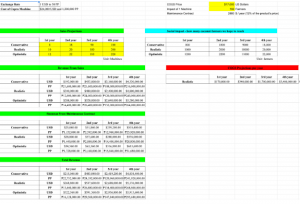- Develop a detailed income statement for your venture for two years (at six month intervals). Explicit state the assumptions that underlie your financial model.



- Identify two SPECIFIC funding sources for the design phase of your project and two SPECIFIC funding sources for the dissemination (implementation / distribution / commercialization) phase of your project. For each funding source, explain why this is a good fit for your project, and what SPECIFIC aspect of your project might the funding source support.
Design Phase:
USAID: $35 Million Water and Energy for Food Challenge (WE4F)
This initiative aims to increase sustainable agricultural and food value-chains, food security, and climate resilience in developing countries and emerging markets – with a focus on the poor and women by investing in small enterprises that work in combinations of food, water, and energy. This grant seems like a good fit to our project because our coconut processing in the Philippines lies in the perfect intersection of energy, water, and technology.
Source: https://www.usaid.gov/news-information/press-releases/oct-23-2019-usaid-announces-35-million-water-and-energy-food-challenge
The Global Innovation Fund supports the development of social impact ventures by investing in innovations that aim to improve the lives and opportunities of millions of people in the developing world. This investment is an appropriate fit for our project because our goal is to improve the lives of coconut farmers in the Philippines by generating additional income through the innovation of a new technology that processes value-added coconut products.
https://www.globalinnovation.fund/
Dissemination Phase:
SOW Asia is a charitable foundation based in Hong Kong that supports early-stage social enterprises working to scale their social impact. They have an accelerator program that supports social enterprises by providing investments through opening networks to help build connections and find funds. Their goal and vision is to help local social enterprises attract external funding and become self-sustaining. Due to the fact that SOW Asia is looking to increase impact, we believe that they could be a perfect match for our project when we reach the point where we are ready for dissemination and scaling.
http://www.sowasia.org/about-sowsaia
DBS supports over 100 social enterprises in Asia since 2012. They support social enterprises that are looking to scale their business to increase social impact by improving operational capacity, innovation capabilities, and geographical reach. Specifically, they look to support social enterprises that not only have a market validated business product/solution with clear plans to scale up business, but are also committed towards scaling social impact. We believe that once our venture is up and running, financial support from DBS will prove very helpful as we try to scale up.
https://www.dbs.com/foundation/our-support/grant-programme
- Identify five specific partnerships that you need to forge to advance your project forward with the ultimate goal of positively impacting at least one million people. Describe exactly how that partnership might help you achieve scale and why that entity might be willing to work with you.
Philippines Coconut Authority (PCA)
PCA is an agency of the Philippine government under the Department of Agriculture mainly responsible for developing the coconut industry to “its full potential in line with the new vision of a united, globally competitive and efficient industry.” The PCA might be willing to work with us, because our goal aligns well with their mission – we aim to develop a novel value-added coconut processing that will improve the livelihood of coconut farmers. If our technology and products are approved and endorsed by the PCA, this will help increase our credibility and improve our product’s marketability. In addition, our partnership with PCA will give us the opportunity to reach out to a rigorous network of coconut companies and, of course, a community of 3.5 million coconut farmers.
UPD
Our partnership with UPD will allow us to leverage the proximity of the HEED students working on the project in the Philippines to the copra farmers. Their ability to access stakeholders who can be easily reached in the Philippines will help drive our project forward by allowing us to utilize important stakeholder information without physically being there. This partnership will also provide us with additional research from UPD students and will act as a resource for getting to know specific aspects of the Philippines that influence our project.
The Philippines Partnership for Sustainable Agriculture (PPSA)
PPSA brings together companies, government agencies, civil society organizations, farmer groups, and financial institutions to link smallholder farmers to the market. Their main goal is to improve farmers’ profitability and productivity while increasing environmental sustainability. As our project aims to improve the livelihood of smallholder farmers, partnering with this organization will give us more direct access to the smallholder farmers and allow us to have a larger impact on their lives.
Axelum Resources Corporation
Axelum Resources Corporation is a Filipino company with a global mindset. They deliver premium products to the global market while maintaining a spirit of communal unity, work, and cooperation. A partnership with Axelum would prove beneficial for both sides. We would trade our processed goods to them, which would provide both sides with security. In addition, by partnering with us they would be able to continue to support local communities as that is part of our mission as well.
Innovation For Social Impact Partnership (isip)
This partnership aims to support innovative social enterprises in the Philippines to collectively contribute to the achievement, acceleration, and sustainability of sustainable development goals. They provide targeted assistance to SE’s in becoming scalable and sustainable ventures that create a positive social change through workshops and mentorship programs. This partnership would be willing to work with us because our goals align and we are also focused on creating a novel, sustainable, and social change for copra farmers in the Philippines.







Recent Comments